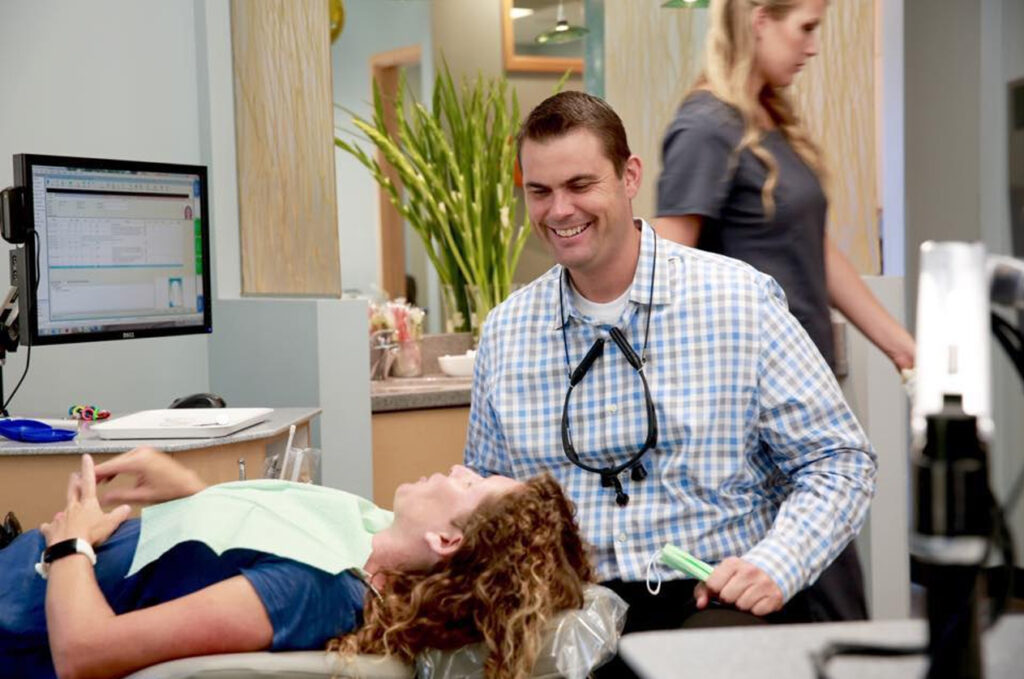Surgical Orthodontics
Cutting-edge results sometimes require state-of-the-art surgery
What is surgical orthodontics?
Just as orthodontics repositions teeth, surgical orthodontics (also known as orthognathic surgery) corrects jaw irregularities to improve your ability to chew, speak, and breathe as well as making you look better in general. In other words, surgical orthodontics straightens your jaw. Moving the jaws also moves the teeth, so we always use braces in conjunction with jaw correction. This helps make sure teeth are in their proper positions after surgery.

Who needs surgical orthodontics?
Dr. Allen will consider surgical orthodontic treatment for non-growing adult patients that suffer from improper bites and those with facial esthetic concerns. Typically, jaw growth is completed by age 16 for girls and 18 for boys. All growth must be completed before jaw surgery can be performed. However, the pre-surgical tooth movements can begin one to two years prior to these ages.
How does it work?
During your orthodontic treatment, which usually lasts 6-18 months, you’ll wear braces and will visit your orthodontist for scheduled adjustments and check-ins. As your teeth move with the braces, you may think that your bite is getting worse rather than better. However, when your jaws are placed into proper alignment during orthognathic surgery, the teeth will then fit into their proper positions.
Surgery is performed in the hospital with an oral surgeon and can take several hours, depending on the amount and type of surgery needed. In lower jaw surgery, the jawbone behind the teeth is separated and the tooth-bearing portion is moved forward or backward, as needed. In upper jaw surgery, the jaw can be repositioned forward or backward, or the jaw can be raised or lowered. Certain movements may require the jaws to be separated, with bone added/removed to achieve the proper alignment and stability. Other facial bones that contribute to alignment may also be repositioned or augmented.
When you have completed surgery, you should be able to return to school or work within two weeks. After the necessary healing time (about 4-8 weeks), your orthodontist will “fine-tune” your bite. In most cases, braces are removed within 6 to 12 months following surgery. After your braces are removed, you will wear a retainer to maintain your new smile throughout your life.
How it Works

1. Getting to Know You
At your first visit to our Oceanside orthodontist office, diagnostic records – typically photos of your face and teeth, as well as x-rays – to determine the best course of treatment. We use this information to develop a custom treatment plan that’s unique to your needs and goals. These records are also helpful in tracking the progress of your treatment as your teeth begin to move and shift into the optimal position.

2. Custom Treatment Plan
We’ve invested in the latest orthodontic technology so that we can provide each patient with a customized treatment plan that’s not only perfect for jaw structure and their specific goals but also their budget. After Dr. Allen evaluates your records, we’ll discuss our recommended treatment plan with you in detail, including the payment options.
No matter your age, we can help you get the smile you’ve always wanted.

3. Your New Smile
At Allen Orthodontics in Oceanside, we don’t just make smiles more beautiful, we help you discover your true smile – a smile infused with real confidence. Because when you’re no longer afraid to smile you become more open, more honest, and more present in everyday moments. This is what we want for all of our patients. So, let’s do this San Diego County. Let’s uncover the true you by discovering your true smile.
FAQs About Teens
Do braces hurt?
Braces or Invisalign don’t “hurt,” but for the first couple days you may feel some slight discomfort. When there is soreness, Motrin or Advil (ibuprofen) can help ease the discomfort.
Can I return to school the day I receive my braces?
Absolutely. There’s no reason why you shouldn’t be able to return to your normal daily life.
Will my teeth straighten as I grown?
Unfortunately, no. Orthodontic issues, such as spacing and malocclusions, tend to worsen with age. It’s important to be examined as early as possible, to ensure these problems are corrected sooner rather than later.
Can I schedule all of my appointments after school?
We do our best to schedule you for the most convenient times based on your busy schedule, but cannot make any guarantees. However, most appointments are scheduled 4-10 weeks apart, so you or your child will miss minimal work/school time.
Can I still play sports with braces or aligners?
Of course! We do recommend that you use a mouthguard to protect your mouth during treatment.
What are you waiting for?
Who You Are is Amazing. Your Smile Should Be Too.
Ready to start your smile transformation? Look no further than Allen Orthodontics, where we specialize in creating beautiful smiles that will leave you feeling confident and happy. Our experienced team is dedicated to providing exceptional orthodontic care tailored to your unique needs. Visit us today, and let us help you achieve the smile of your dreams!

